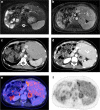Impact of 18F-FDG-PET/CT on Clinical Management in Patients with Cholangiocellular Carcinoma
- PMID: 34286178
- PMCID: PMC8256695
- DOI: 10.1259/bjro.20210008
Impact of 18F-FDG-PET/CT on Clinical Management in Patients with Cholangiocellular Carcinoma
Abstract
Objective: To determine the impact of 18F-FDG-PET/CT on clinical management of patients with cholangiocellular carcinoma (CCA).
Methods: Patients with CCA undergoing clinically indicated 18F-FDG-PET/CT between 04/2013 and 08/2018 were prospectively included in a local PET/CT registry study. Intended clinical management ("non-treatment" such as watchful-waiting or additional diagnostic tests, and "palliative" or "curative treatment") was recorded before and after PET/CT. Changes in intended management after PET/CT were analyzed.
Results: 27 patients (mean age: 60 years, IQR: 51.5-67.5 years, 56% males) with 43 PET/CT examinations were included. Intended management changed in 35/43 cases (81.4%) following PET/CT. Major changes (i.e., between "non-treatment" and "treatment" strategies or between a "curative" and "palliative" treatment goal) occurred in 27/43 (62.8%) cases. Before PET/CT, additional imaging and/or biopsy were intended in 21/43 (48.8%) and 9/43 (20.9%) cases, respectively. After PET/CT, further imaging was carried out in one case and imaging-targeted biopsy in eight cases. Although the absolute number of biopsies after PET/CT did not decrease, in only one of these eight cases biopsy had already been planned before PET/CT, whereas in the other eight cases, the originally planned biopsies were dispensable after PET/CT.
Conclusions: 18F-FDG-PET/CT significantly impacts clinical management of patients with CCA. It guides decisions on treatment strategy (especially curative vs palliative treatment goal) and on additional tests, particularly by helping referring clinicians to avoid unnecessary imaging and by guiding targeted biopsy.
Advances in knowledge: Systematic implementation of 18F-FDG-PET/CT may enable a more appropriate and tailored treatment of patients with CCA, especially in cases of suspected recurrence.
© 2021 The Authors. Published by the British Institute of Radiology.
Figures





Similar articles
-
How [18F]-FDG-PET/CT Affects Clinical Management of Patients with Germ Cell Tumors in the Real World.Cancers (Basel). 2023 Jul 17;15(14):3652. doi: 10.3390/cancers15143652. Cancers (Basel). 2023. PMID: 37509313 Free PMC article.
-
Role of Pre-therapeutic (18)F-FDG PET/CT in Guiding the Treatment Strategy and Predicting Prognosis in Patients with Esophageal Carcinoma.Asia Ocean J Nucl Med Biol. 2016 Summer;4(2):59-65. doi: 10.7508/aojnmb.2016.02.001. Asia Ocean J Nucl Med Biol. 2016. PMID: 27408893 Free PMC article.
-
Diagnostic and prognostic value of 18F-FDG PET/CT in recurrent germinal tumor carcinoma.Eur J Nucl Med Mol Imaging. 2018 Jan;45(1):85-94. doi: 10.1007/s00259-017-3811-4. Epub 2017 Aug 22. Eur J Nucl Med Mol Imaging. 2018. PMID: 28828589
-
18 F-FDG PET/CT imaging of small intestinal metastasis from pulmonary sarcomatoid carcinoma: Brief report and review of the literature.Thorac Cancer. 2020 Aug;11(8):2325-2330. doi: 10.1111/1759-7714.13468. Epub 2020 May 15. Thorac Cancer. 2020. PMID: 32410331 Free PMC article. Review.
-
Diagnostic Accuracy of 18F-FDG PET/CT in Infective Endocarditis and Implantable Cardiac Electronic Device Infection: A Cross-Sectional Study.J Nucl Med. 2016 Nov;57(11):1726-1732. doi: 10.2967/jnumed.116.173690. Epub 2016 Jun 3. J Nucl Med. 2016. PMID: 27261514 Review.
Cited by
-
The potential advantages of 18F sodium fluoride positron emission tomography-computed tomography for clinical staging and management planning in patients with nasopharyngeal carcinoma.Quant Imaging Med Surg. 2024 May 1;14(5):3393-3404. doi: 10.21037/qims-23-1671. Epub 2024 Apr 8. Quant Imaging Med Surg. 2024. PMID: 38720843 Free PMC article.
-
PET-CT in Clinical Adult Oncology: III. Gastrointestinal Malignancies.Cancers (Basel). 2022 May 27;14(11):2668. doi: 10.3390/cancers14112668. Cancers (Basel). 2022. PMID: 35681647 Free PMC article. Review.
-
Standardized Response Assessment in Patients with Advanced Cholangiocarcinoma Treated with Personalized Therapy.J Pers Med. 2024 Dec 6;14(12):1143. doi: 10.3390/jpm14121143. J Pers Med. 2024. PMID: 39728056 Free PMC article.
-
[Cholangiocarcinoma-Intrahepatic to hilar bile duct cancer].Chirurgie (Heidelb). 2022 Jul;93(7):644-651. doi: 10.1007/s00104-022-01660-5. Epub 2022 Jun 13. Chirurgie (Heidelb). 2022. PMID: 35771272 German.
-
How [18F]-FDG-PET/CT Affects Clinical Management of Patients with Germ Cell Tumors in the Real World.Cancers (Basel). 2023 Jul 17;15(14):3652. doi: 10.3390/cancers15143652. Cancers (Basel). 2023. PMID: 37509313 Free PMC article.
References
-
- Bragazzi MC, et al. . Cholangiocarcinoma: epidemiology and risk factors. Transl. Gastrointest. Cancer 2011; 1: 21–32.
LinkOut - more resources
Full Text Sources

